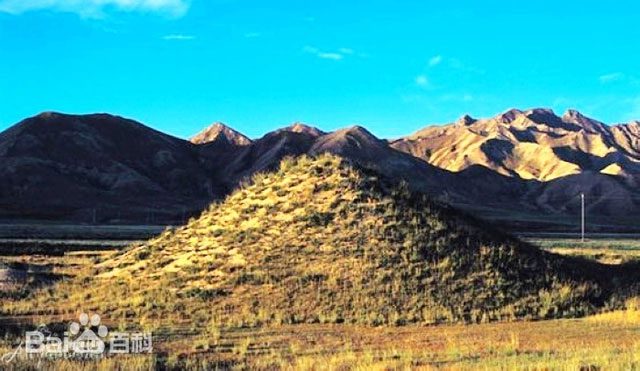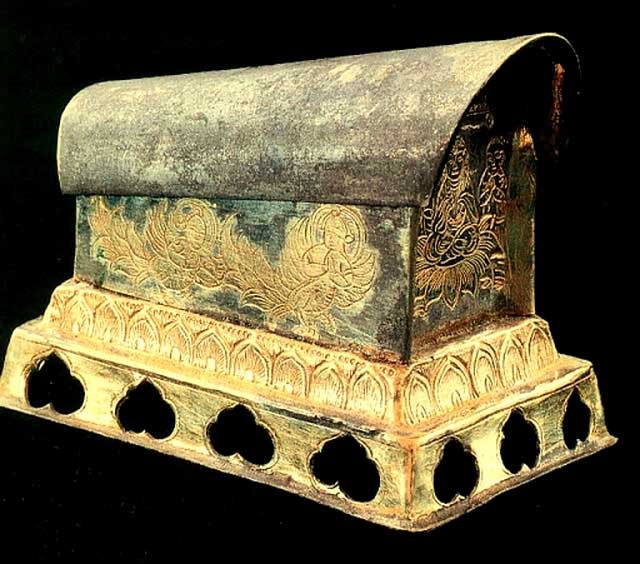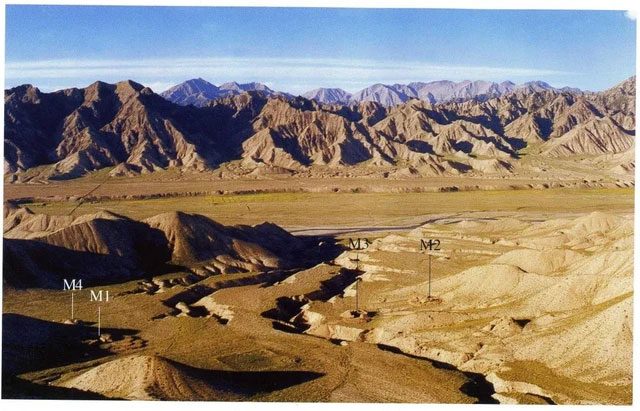This discovery has sent shockwaves through the Chinese archaeological community.
Over four decades ago, China first uncovered the Tibetan Royal Tomb Complex, which consists of more than 100 various tombs located in the hot springs area of Ritu, Dulan County, Qinghai Province, in western China.
This monumental discovery has been so significant that experts in China continue to unearth historical narratives from the artifacts buried here.
42 Years of Uncovering New Records
In fact, the place name Ritu is derived from the numerous hot springs that have existed for thousands of years in this region.
“The hot water in Ritu is like holy water, precious as a golden spring.” – This was the reflection of Emperor Kangxi (1654-1722) after he visited the area multiple times to cleanse his royal body following his battles since 1678.
Not only are there golden spring-like hot waters, but Ritu also hosts a vast tomb complex that has been classified as a “national treasure” by China.
The story began in 1982 when the Qinghai Provincial Archaeology and Cultural Relics Team accidentally discovered a group of ancient tombs during a survey of cultural relics in Ritu Town, Dulan County.
Following this, the Qinghai Provincial Institute of Cultural Relics and Archaeology immediately began excavation and exploration. In total, they conducted four unprecedented excavations at the Jingpeng Pass on the Tibetan Plateau.

One of the tallest mounds in the Tibetan Royal Tomb Complex. (Photo: Baidu).
From 1982 to 2024, a robust team of Chinese and international archaeologists has made significant discoveries: They discovered the Tibetan Royal Tomb Complex, consisting of over 100 different tombs located at elevations ranging from 3,200 to 3,500 meters in Ritu. The tombs are scattered over an area approximately 7,000 meters long in four villages of Ritu, dating from the 8th to 9th centuries.
Since this tomb complex was discovered in Ritu, it is also referred to as the “Ritu Tombs” (Hot Spring Tombs). What astonished the Chinese archaeological research community is that this is the first large Tibetan tomb complex discovered in the country.
So, what has China gained from this colossal treasure trove?
1. A treasure of gold, silver, and rare artifacts
At the Tibetan Royal Tomb Complex, archaeologists have unearthed a treasure in the literal sense.
Among the more than 100 tombs in Ritu, scientists have found countless jewelry and items made of gold and silver from Sogdiana (in Iran), luxurious silk fabrics, agate beads, bronze plates, bronze perfume bottles, and many other ‘noble’ items and cultural relics.

One of the exquisitely crafted gold artifacts. (Photo: Baidu).
Additionally, they discovered many extremely rare artifacts of significant contemporary historical value, such as items made of precious wood, various types of brocade (among which are embroidered fabrics with gold thread, first discovered in China), and numerous Persian textiles of quality comparable to modern standards, as well as Buddha statues and items from the Western Regions… These are all treasures first discovered in China.

Expert evaluating one of the gold artifacts found at the Ritu Tombs, Qinghai, China. (Photo: Baidu).
These findings prove that the area is an important node on the Silk Road. This part of the historical trading system, spanning 6,437 km connecting Asia to Europe, has had the opportunity to be revived after thousands of years buried underground.
Specifically, the discovery of finely crafted and distinctive Sogdian gold and silver – indicating that merchants from Iran came to China to exchange goods – underscores this point.
2. The Land “Backed by Mountains, Facing the River”
Since the owners of the tombs belonged to the royal and noble classes, a common luxurious feature of these tombs – alongside their very “noble” burial items – is that all the tombs are covered with multiple layers of cypress wood.
This characteristic is just one of the ways of burial that strictly adheres to ancient feng shui principles, which were highly valued by the ancients. Just look at how elaborately and meticulously they buried these hundreds of tombs to seek great fortune!
Since ancient times, humans have yearned for a life of wealth and prosperity, sustainable family development, and a thriving nation. This aspiration holds true even when a person has passed on to the next world. Thus, choosing ancestral burial sites that align with feng shui and dragon veins is a way for the living to believe that the deceased can assist their descendants for generations to come.
The Tibetan Royal Tomb Complex fully meets ancient feng shui standards. Most of the tombs are “backed by mountains and facing rivers,” all providing a sense of being sheltered by the mountains and opened to the world by the rivers.
Moreover, the tombs are covered with cypress wood. Above the nine layers of cypress wood lies a layer of gravel, followed by a layer of soil and the burial mound. The bottom of the tomb is often paved with stone and wooden planks.

The Tibetan Royal Tomb Complex consists of four large burial clusters (from M1 to M4) scattered over an area approximately 7,000 meters long in four villages of Ritu. (Photo: Archaeology (China)).
Among the four large burial clusters (marked M1, M2, M3, M4), there is one largest tomb. This largest tomb is situated on a natural hill 30 meters high, backed by the Ritu Mountain and facing the river, majestic like a city. The burial mound (the added earth) will be 11 meters high, 55 meters long from east to west, and 37 meters wide from north to south.
From top to bottom of the tomb, there is a layer of wood arranged neatly over the burial mound every meter, totaling nine layers, all made of cypress wood of average thickness. This form and style of tomb construction is the only one observed in all archaeological excavations conducted in China.
In front of each burial cluster’s gate, there are more than 70 animal skeletons, including cattle, horses, sheep, dogs, and deer buried as part of the offerings for the deceased. Moreover, the tomb complex is built in a dangerous terrain, implying that the owners of the tombs are protected from “living intruders.”

Animal burial pits in front of each burial cluster’s gate. (Photo: Archaeology (China)).
Remarkably, archaeological discoveries in 2018 at Tomb No. 1 (M1) proved that this is one of the highest-level tombs with the most complete layout, clearest structure, and most complex shape found in this entire complex and even on the Qinghai-Tibet Plateau.
This indicates how much “feng shui masters” thousands of years ago valued and adhered to strict and meticulous feng shui principles in tomb construction.
3. Unlocking the Door to Deciphering the “Tibetan Code” from Millennia Ago
Academic circles and Chinese historical experts believe that excavating the Tibetan Royal Tomb Complex holds tremendous value for researching the history of Tibetan civilization, studying the types of tombs in western China during the pre-Tang period, understanding cultural exchanges/trade between the local area and Central Asia, as well as discussing the origins of the Tibetan people.
A significant amount of silks and brocades unearthed from the tombs clearly demonstrates that from the late 6th century to the late 8th century, Qinghai was one of the key trade nodes on the Silk Road and a crucial transit point for East-West trade.
This is why the tomb complex, located at an altitude of 3,500 meters, is highly valued by China and the world in general.
In 1983, the Ministry of Culture recognized this complex as one of the six significant discoveries in China.
In 1996, with additional important findings in the complex, it was recognized by the State Administration of Cultural Heritage as one of the top 10 archaeological discoveries of China in 1996, and subsequently became a key national cultural heritage site.
In 2021, after new archaeological findings in 2020, the Tibetan Royal Tomb Complex was selected as one of the top 10 new archaeological discoveries in China in 2020.
Notably, in October 2021, this complex was further chosen as one of the top 100 archaeological discoveries of the century.
Currently, this tomb complex continues to attract Chinese archaeologists for exploration and deciphering.




















































